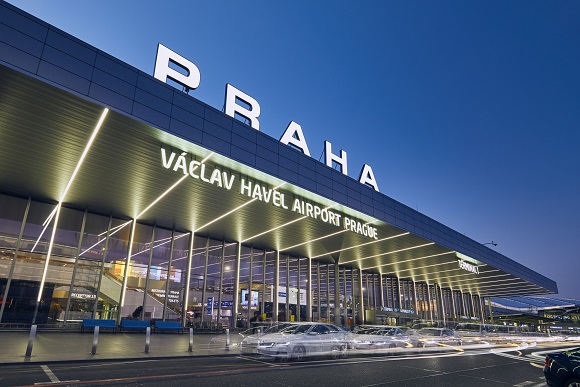
Only a handful of cities in the world can claim a history as rich and diverse as that of Prague. During the thousand years of its existence, Prague has been home to Holy Roman Emperors, a seat of the Austro-Hungarian Empire, capital of Bohemia and even one of the most important cities in the eastern bloc after the second world war.
These days, Prague is a bustling and cosmopolitan European capital which welcomes nearly 10 million visitors per year. According to TripAdvisor, travellers rank it as the 9th best location in the world. Many of these come through its main international airport in the Czech Republic, Vaclav Havel Airport Prague, which was founded in 1937
We recently interviewed Roman Pacvon, spokesperson for the airport, about its progress over the past while and where it plans to be in the years ahead. The impression that emerged from the interview is of an airport with a vision which extends 20 years into the future, and ever-growing passenger numbers.
Overview
We began by asking Mr. Pacvon about the airport’s recent growth, and how that affects the airport. He told us: “Passenger numbers have been growing year-on-year since 2013. In 2018, as per the latest operating results, Prague Airport handled approx. 17 million passengers, which represents a 9% year-to-year growth. In 2019, we expect to handle more than 17.5 million, which will represent another record.”
The growth has come through a good mix of European and long-haul flights, he says: “In summer season 2019, our airport offers direct connections with 162 destinations all around the world operated by 69 airline companies. Our network also includes 16 long haul destinations (the most in recent history of the airport). This summer two new significant services are commencing: direct service to Newark in New York operated by United Airlines and direct connection to Shenzhen in China operated by Sichuan Airlines.”
In total, more than the airport facilitated over 155,000 take-offs and landings in 2018, representing 5% growth on the year before. On average in 2018, 46 thousand passengers passed through the airport each day. In 2018, total of 69 carriers operated their flights from Prague, connecting the airport with 171 destinations all around the world and that annual figure also continues to swell.
This growth, it should be pointed out, hasn’t come at the expense of providing a high-quality service. For example, in 2017, Václav Havel Airport Prague was achieved the status of Highly Commended Airport at the ACI Europe Best Airport Awards while in 2018, it was among the best European airports in category of 15 – 25 million handled passengers at Airport Service Quality Awards 2018 (ASQ).
Socio-Economic Benefits
Prague Airport is also a major socio-economic contributor to the Prague Area both within and outside the aviation related business. Of this, Mr. Pacvon says: “We have recently begun closely cooperating with our partners also active in tourist industry, such as Czech Tourism, Prague City Tourism and Central Bohemian Region.”
Together they established a program called Touchpoint which targets visitors from further flung destinations such as the United States, Japan, China, India, Thailand etc. Mr. Pacvon says: “Our target is also motivate tourists to stay longer as well as encourage them to visit also other regions in the Czech Republic besides Prague.”
The socio-economic impact of the airport is further underlined by the figures provided by the airport’s spokesperson: “Prague Airport is a significant contributor to regional employment rate. Currently, the airport itself has more than 2,500 employees and the Prague Airport Group as a whole employs more than 4,500 people, with about 300 new positions opening up every year.”
Future Developments
The airport’s promotional video, ‘Prague Airport - Future Vision’ is a peep into the future of travel. The final decision on how to proceed with the construction of the parallel runway and expanded Terminal 2 will conclude later this year. The airport authority expects that implementing this phase of its development plan will allow Prague Airport to cater for up to 21 million passengers annually.
In the more immediate future, the airport is keen to continue advancing its technological development. Mr. Pacvon points out that the airport has recently launched the PRGAirportLab initiative, which aims to monitor the latest trends in new technologies with regard to the airport’s development and to implement selected projects. Examples of such technologies include biometrics, virtual reality, smart parking, virtual taxi, holograms, autonomous cars and robots.
Environment and Sustainability
Prague Airport is proactive in minimizing its environmental impact, and has been certified pursuant to the CSN EN ISO 14001:2005 technical norm of Environmental Management System (EMS) since 2002. This means that it must undergo a thorough (and increasingly strict) examination process by the certification body every three years. For its part, the airport conducts a monitoring audit every year.
Its commitment to the environment and sustainability can be seen in its efforts to reduce noise for the surrounding area, monitoring air quality and reducing carbon emissions on an ongoing basis, water protection, responsible waste management of all of the waste produced at within the airport’s confines and extensive environmental monitoring, which takes in soil, air, water and flora in the airport environment.
The airport has also conducted an innovative air quality biomonitoring project since 2011. This involves maintaining five beehives in the airport’s south area, and analyzing the honey produced by the bees to monitor the amount of foreign objects present. Not only does this ensure that the airport is complying with the highest environmental standards, it also allows it to produce its own range of honey, which it can then be used as a quirky (and of course, delicious) promotional gift from Prague Airport.
Partners and Suppliers
The continuing modernization of Prague Airport requires buy-in from its partners and the airport is lucky to be able to call on a number of partners. Miss Katerina Pavlikova, spokesperson of Prague Airport’s daugher companies, is keen to name-check many of these companies which help it deliver the high standards of quality that vistitors to the airport have come to expect. First and foremost among these is Czech Airlines Handling - a daughter company of the airport.
“Czech Airlines Handling provides high quality ground handling services at Václav Havel Airport Prague, which include passenger, aircraft, cargo and mail handling. Its service portfolio also includes ticket sales, ticketing and call centre operations, and aircraft cleaning. In co-operation with PKN Orlen, CSAH also arranges the supply of fuel for air carriers and provides quality handling services to nearly forty clients,” she says.
“Czech Airlines Technics, another daughter company, focuses primarily on aircraft repair and maintenance and aircraft equipment within the scope of base maintenance, line maintenance, component maintenance, engineering and landing gear maintenance. Last year, the company processed over 120 base maintenance jobs on B737, A320 Family and ATR aircraft, primarily on foreign customers' aircraft.”
On the airport services side, many companies works at Prague Airport, for example Menzies Aviation (Czech Republic), ground handling provider, MaidPro Service s.r.o. , which provides assistance, sanitary and cleaning services, Atalian CZ s.r.o., or Alpha Flight, a.s. (dnata), the international catering company. For the ongoing developments at the airport, various construction and logistics works are provided by different firms choosed in the transparent tenders.
Big Milestone Ahead
Some big milestones await Prague Airport in the years ahead. For one, it’s likely to reach 20 million passengers within the next decade (and possibly even within the next half-decade). Beyond that, in 2037, it will celebrate 100 years of existence, making it one of the first airports in the world to reach that milestone. The airport is likely to play an even more integral role in the city’s and region‘s development in its second century.
Mr. Roman Pacvon notes: “Our target is to be the airport of the choice not just for passengers in our region but also for people from the entire catchment area, which covers the Bohemian region, eastern Germany (the Dresden area) and parts of northern Poland. We want to attract passengers from this area by easy and seamless accessibility, quality of services and extensive network of direct services to the destinations with the highest demand.”
research by Joseph Philips
DOWNLOAD
 PragueAirport-May2019.pdf
PragueAirport-May2019.pdf














